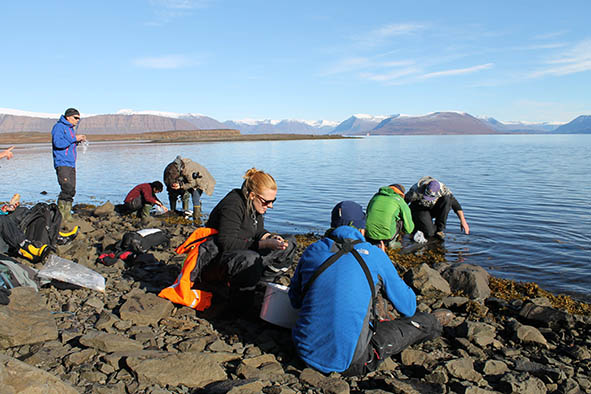The blue mussel (Mytilus edulis) is on the run, a historical run. Blue mussels are currently expanding towards the North with an unprecedented pace, taking over new areas along the way.
Blue mussel is an ecologically well-studied species that often dominates the coastal zone, where these characteristic bivalves form a specific habitat with a distinct associated fauna. Such habitat formers, which influence ecosystem structure, have a potential for wide impact if they are able to migrate into new areas due to changing climate. With the record increase in ocean temperatures, the blue mussel has already expanded its northern distribution well into the High-Arctic region.
My PhD project at Aarhus University aims to investigate the distribution, abundance and physiological adaptation of the blue mussel along the West Greenland coast. Thus, my participation in the “ForBio marine field course, Greenland” was of central importance for my project. During my “individual project” in the course, more than 4500 blue mussels were collected at several prime locations! All mussels were measured, weighted, and aged by counting growth rings – a work accomplished by the energetic ‘Team Mussel’, mainly consisting of Josefin and me – Jakob. In spirit though, everybody on the course was a part of this amazing team, and I thank them all for helping out by collecting Blue Mussels in Disco Fjord, while I stayed behind at the station for physiological measurements in the quiet laboratory.
In the final days we expanded our project, collecting material for comparing population dynamics of mussel beds in the low and high tidal zone. To catch the low tide, Josefin and I went on a rainy, cold and dark morning to collect mussels. Despite the early hour, lack of coffee, and no breakfast, we returned to the lab in the rising sun with a whole bunch of mussels. Mette and Jenny had finally seen the light and joined ‘Team Mussel’ full time to help getting everything done in time.
All blue mussel data collected during this course will be used to increase our understanding of the ecological consequences of the expanding blue mussel in the Arctic. By comparing population dynamics and macrophysiology among populations found at Nuuk, Disko Island, Upernavik and Qaanaaq, our studies will allow us to better understand the direct (and indirect) impacts of the changing Arctic climate. Eventually, we hope to expand our knowledge of how species susceptible to expand their current distribution range will influence current ecosystem structure and function in a warmer future.
By Jakob Thyrring (Aarhus Universitet)




